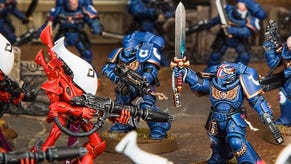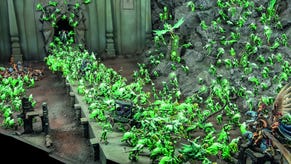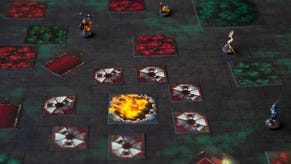Warhammer 40,000: 10th Edition review - a smart, smooth rules refinement that lays a very solid foundation for the wargame’s next era
Our thoughts on the latest iteration of Games Workshop’s flagship miniatures game after a few weeks with the new ruleset.
Warhammer 40,000: 10th Edition has now truly arrived. The rules and launch box have been around for a couple of weeks and the new starter sets are nearly here. (I particularly recommend the Ultimate Starter, it’s the best game-in-a-box product Games Workshop has made in years.) We’ve already talked about the Leviathan launch box, but that’s just a collection of very lovely miniatures and a fancy big-book version of the rules. Ultimately, it’s those rules - which are available in assorted other formats, including free PDF and app versions - that are relevant to the question we’re looking at today: is the new 10th edition of Warhammer 40k any good?
10E isn’t a radical departure from the previous edition. This is still Warhammer as we know it. You and your opponent take turns moving, shooting, charging and fighting with your armies, rolling big handfuls of d6 in the process. GW’s mantra for this edition is “simplified, but not simple”, and that has manifested as a streamlining of many elements, making for a much easier game to comprehend and a smoother playing experience.
Take a look at the datasheet for your favourite unit and a few things immediately jump out. There’s a brand new ‘objective control’ stat which is used in - you guessed it - determining who has control of a contested objective, and leadership is now presented as a number you have to roll over, rather than under, bringing it in line with other stats. The other big change is that the stats for attacking, weapon skill, ballistic skill and strength have been moved off the main stat line and into weapon profiles, much like Age of Sigmar.
It may not seem like a huge deal, outside of presentation, but it’s a great illustration of how 10th Edition cuts down on unnecessary complexity. Weapon profiles no longer have individual special rules; by attaching the chance to hit to the weapon profile and introducing keywords with universal special rules, all the variation you could need from different weapons is combined into one system. It’s not only easier to remember, but easier to communicate with your opponent too.
10th Edition isn’t a radical departure from the previous edition of 40k, but it cuts down on unnecessary complexity.
In a departure from Ninth Edition, virtually every unit, even the most bread-and-butter line troops, has at least one special rule, but rarely more than two or three. This may seem counter to all the streamlining I’ve been gushing about so far, but it’s important to bear in mind that complexity isn’t inherently bad, only unnecessary complexity. There’s still a need for depth and uniqueness. The special rules on each unit not only give each one a different role in your army, but also help to convey that role. Those line troops will almost certainly have a rule that makes them stronger when taking or holding objectives which makes it obvious what they’re used for and why you would take them in your force instead of something with more pizazz.
It helps that all these unique rules are right there on the datasheets. One of the issues 9E suffered from was overly-complex army rules. A given unit might not have had any special rules on the datasheet, but there would be several pages of rules for the army, plus potentially dozens of stratagems, psychic powers, relics, warlord abilities and so on. A quick look at my Codex Space Marines reveals over 20 pages of army rules. While we don’t yet have any 10th Edition codexes to make a direct comparison, the army rules in each index take up five sides of the index cards, which roughly translates to just two pages in a book.
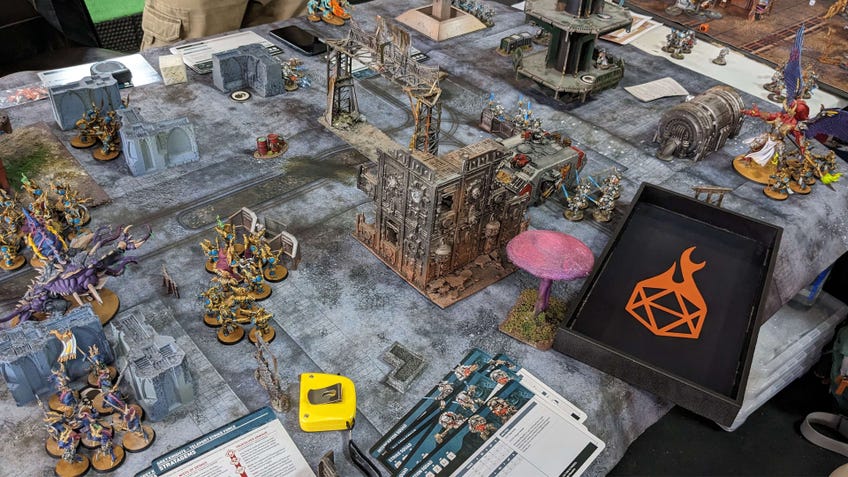
That’s not to say that those rules are all gone; they’ve just been redistributed. Psychic powers, for example, are now either attacks - which have weapon profiles the same as any other weapon - or they’re special abilities on datasheets. (There’s no separate psychic phase, either.) Space Marines’ army rule that allowed them to rapid fire their bolters is now taken care of by keywords in the weapon profiles.
What remains are army rules, detachment rules, stratagems and enhancements. Army rules are based on your faction. This is generally the unique schtick each faction has, like Aeldari being able to manipulate the Strands of Fate or the Adepta Sororitas’ access to Miracles.
All these changes result in a much smoother-running game.
Your detachment represents what kind of force your army is. It provides a single army-wide detachment rule, six stratagems and four enhancements, which are special abilities you can give to your characters. At the moment, each faction only has access to a single detachment portraying the most typical force they field - the exception being the more unconventional Space Marine chapters, such as the Space Wolves and Black Templars, who each have their own detachment. (GW has stated that more detachments will be a feature in the forthcoming codexes and will include things like Tyranids being able to choose a detachment that favours large monsters, or one that plays to the strengths of huge swarms of smaller creatures.)
Detachments aren’t the only way army-building has been streamlined. Force organisation charts are gone, replaced by a very simple set of rules. You must have at least one character to be your warlord, and units are limited to one if it’s an epic hero (these are your named characters), six if it has the Battleline keyword and three in all other cases. That’s it.
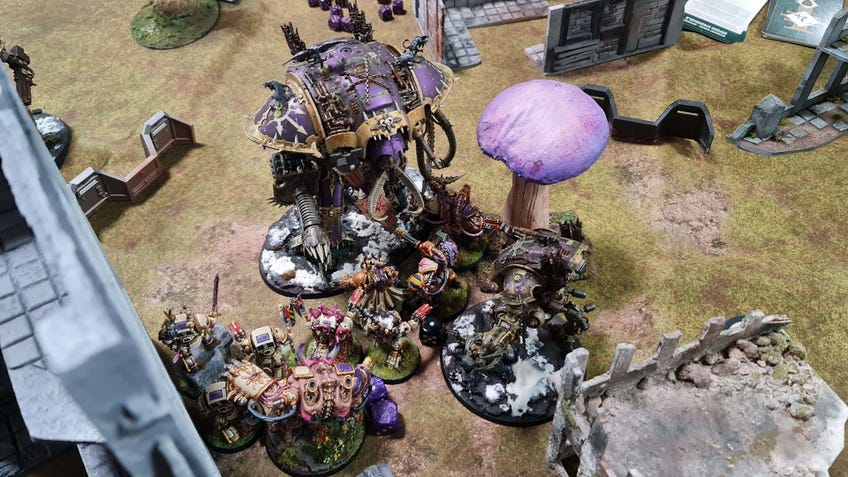
Points have been heavily simplified, with each unit having a fixed cost and set sizes. Changing up the loadout of your troops no longer affects their cost, so you may as well take the best gear you can. Of all the changes, this is potentially the most controversial, simply because many players enjoy finely-detailed list-building - and this cuts down on that considerably. It’ll also cause problems for people with non-standard-sized units. Whereas before you could take a unit that had between five and ten troops, paying extra points for each one beyond the basic five, you now either pay the cost for five or the cost for ten. That said, the unit sizes correspond to the number of models GW sells in a box; it’s already responded to feedback and added an option for Plague Marines to come in squads of seven, since that was the one exception.
In practice, all these changes result in a much smoother-running game. Command points, which you spend to use stratagems, have been cut right back. You don’t start with any at all, and only gain one at the start of each player’s turn. There are some abilities that allow you to gain more, but these are capped at one extra each turn. There are now 11 universal stratagems available to everyone, while your detachment provides six more. It’s much easier to get to grips with than the couple of dozen or so unique stratagems that each army had in 9E, especially as the universal ones mostly cover quite generic actions, such as spending a command point to reroll or shoot at a unit that is charging one of yours. It only took me a couple of games for them to become second nature. Much like reactions in Horus Heresy, many of them can be used in your opponent’s turn, making for a much more engaging experience. No more nipping to the loo during their movement phase, I’m afraid!
It would be remiss of me not to talk about 10E’s new format, Combat Patrol. It’s essentially a pre-constructed format using the existing Combat Patrol army starter boxes available from GW. It still uses the full core rules, but each Combat Patrol has its own datasheets and army rules that have been tweaked in order to balance them against each other. No small task, as they weren’t designed to be complete armies, just a discounted jumping-off point for a collection. There’s also a set of Combat Patrol-specific missions designed to be played across two of GW’s standard battlemats.
This results in a fast, tense and bloody game that can be played in under an hour once you have a good grip on the basic rules. It’s a great way of learning 40k as there’s less to take on board but it still uses the full ruleset, and it cuts down massively on the time between starting a new army and having something you can play a decent game with.
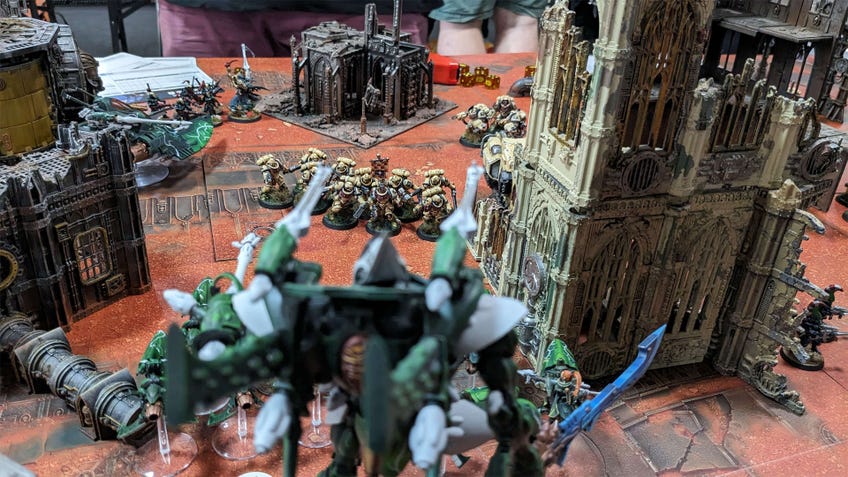
Warhammer 40k: 10th Edition isn’t perfect. Balance issues with various factions became apparent almost immediately, with some clear winners and losers. Death Guard, Adeptus Mechanicus, Tau and Astra Militarum armies are all struggling due to overcosted units, gaps in their ranges (Death Guard suffer from a clear lack of anti-armour firepower) or an overall lack of oomph. On the flipside, Adeptus Custodes, Imperial Knights and Aeldari are all very strong, with the Aeldari in particular having a wide range of strong units and a very powerful army rule. However, this is a very fixable problem, and we’ve already had one points adjustment from GW. The important thing is that the game itself provides a solid foundation - and in that respect 10th Edition has started out strong.
While Warhammer 40,000: 10th Edition isn’t perfect, the important thing is that the game itself provides a solid foundation - and in that respect it has started out strong.
It’s also worth bearing in mind that until codexes start getting released, we don’t have a complete picture - and they could be the make-or-break moment. If they provide more detachment variety for each faction, maybe a few tweaks and some new units (particularly for the likes of newer armies like the Leagues of Votann), then they’re going to be great. If we see the kind of power creep that plagued Ninth Edition, it’ll feel like history repeating.
Overall, I’m really pleased with 10th Edition. 40k has gone from a game I had no interest in playing, to one that I’m actively enthusiastic about. The more flexible army-building rules for regular games and the new Combat Patrol format mean smaller games of 40k are more enjoyable than ever. With the rules being freely available online, now is a great time to jump into 40k for the first time, dust off an old army or dabble with a new one.



